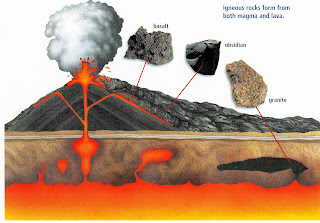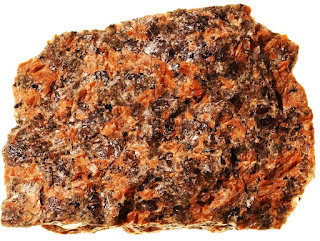Rocks
types of rocks
Rocks are divided as follows into three great groups based on the origin and mode of formation.
- Igneous Rocks: Those that have consolidated at or relatively near the earth's surface from molten material called magma originating from within the earth.
- Sedimentary Rocks: Those produced chiefly by the breaking up of pre-existing rocks and deposition of the broken material in the form of layers.
- Metamorphic Rocks: Those produced from pre-existing rocks by the action of high temperatures and pressures.
 |
| The rock cycle |
Igneous Rocks
Igneous rocks are formed by the cooling of molten material called magma, at or relatively near the earth's surface. Magma is a Naturally formed mixture of molten rocks and minerals deep down the earth. The constituents of magma are mostly complex silicates and oxides of iron, aluminium, magnesium, calcium, sodium and potassium. Silica is always present in 35 to 75%. Most of the constituents of magma are nonvolatile with fusion temperature above 1000°C while some others, small in amount, are of a highly volatile character. Under the pressure of the earth’s rocks, the magma travels to zones of lesser pressure and along weaker planes and fissures in the existing rocks. When it erupts at the surface it is called lava as in the case of a volcano.Rocks formed from the same magma have different names depending upon the crystalline texture which depends upon the rate of cooling which, in turn, depends upon the place of cooling, i.e.whether at depth or at the surface. The rocks which are cooled at depths had a very slow rate of cooling resulting in large coarse crystals and are called plutonic, those that are cooled at intermediate depths had a comparatively faster rate of cooling yielding smaller size crystals and are called hypabyssal; those that cooled at or very near the surface had a fast rate of cooling yielding no crystals but the nearly glassy texture and are called volcanic.
The igneous dykes, sills and lava rocks are found in, Batholith, lopoliths, laccoliths, dykes, sills and lava flows near volcanoes.
Batholith:
It is a large igneous rock mass of irregular outline widening downwards and without a known floor. fig belowLopolith:
it is a large igneous mass which differs from the batholith in that the former has a basin-like shape and a gradually decreasing width with increasing depth.Laccolith:
It is an igneous rock formed from cooling magma which caused the previous beds to arch in the form of a dome. it is much smaller than batholith and has a known floor and domed top.Dyke:
It is a more or, less parallel-sided vertical wall of igneous rock formed due to upward instruction of molten magma generally through fissures or cracks existing in the previous rocks (Fig 1 2) It may be only a few metres or hundreds of metres thick and is a common occurrence in the coalfields, e.g. the dolerite dykes’ and mica peridotite dykes in, most of the coalfields. The coal around the dyke is usually semi-burnt, hard and useless. In some cases, however, coal the dyke is converted into better quality like anthracite or naturally occurring coke which is useful. Dykes stand out as prominent ridges existing over long distances when the comparatively softer surface is eroded. An example of such dyke, seen on the surface, is the Salma dyke in the Ranigunj field which extends from Damra to the West of Kalipahari and beyond. In the Jharia field, a prominent dyke runs along Telmucha, Pipratand, Phularitand and Tundu Metal work, and another runs more or less parallel to the above, but west of Madhuban village across Jamunia stream.Sill:
A sill is a more or less horizontal sheet of igneous rock which extends laterally into the strata, usually introduced between the bedding planes. The thickness may range from a few metres tohundreds of metres. A sill is generally fed by a dyke and is rarely exposed at the surface by erosion of rocks above it.
Lava flows:
The molten erupting to the surface is known as lava. The rock formed after the cooling of lava is termed simply lava. The rocks to the south of the Satpura range in India, known by the nameDeccan Trap, are lavas nearly 300 m thick covering about 3,00,000 sq. kilometres.
The lava flows, as they erupt to the surface, are also called extrusive igneous rocks, and batholith, laccolith, dyke, sill, etc. are called intrusive rocks.
Composition and Classification of Igneous Rocks
Igneous rocks are commonly classified based on their chemical composition. The essential minerals that form the igneous rocks are quartz, mica (muscovite and biotite), felspars (orthoclasef and plagioclase), and ferromagnesian minerals (augite, hornblende and olivine).
based on the silica content, the igneous rocks are classified as acid rocks or basic rocks as follows:
Silica more than 65% - Acid rock, e.g. granite
Silica 55% to 65% - Intermediate rock, e.g. diorite
Silica 45% to 55% - Basic rock e.g. besalt.
Silica is less than 45% - Ultra-basic rock, e.g. Peridotite
The following table shows the classification of common types of igneous rocks based on texture and chemical composition.
| Acid | Intermediate | basic | ultra basic | ||
|---|---|---|---|---|---|
| Plutonic | Granite | Syenite | Diorite | Gabbro | Peridotite |
| Hypabssal | Granite | Syenite | Diorite | Dolerite | |
| Porphyry | Porphyry | Porphyry | |||
| Volcanic | Obsidian | Trachyte | Andesite | Basalt |
Granite, Phophyry and obsidian have same composition but the crystalline texture varies.
The common igneous rocks are:
Granite:
It consists of large sized crystals of quartz, and orthoclase felspar with some biotite (black mica). Greenish crystals of hornblende also may occur. Granite is the most common rock of the plutonic igneous type.
Very coarse granites are called pegmatites and are characterised by large crystals, sometimes 0.3 m across, e.g. at the mica mines near Kodarma (Bihar).
Syenite and Diorite:
These are not deep-seated but hypabyssal rocks. These are darker than granite but have no quartz and contain felspar and biotite or hornblende.
Gabbro:
This is much darker and heavier than granite containing a large proportion of ferromagnesian minerals, such as olivine, magnetite, etc. Dolerite is very widely distributed in dykes and sills and has the same composition as that of gabbro.
Peridotite:
It is a common example of ultra-basic rocks and consists of ferromagnesian minerals, chiefly olivine with some augite and hornblende. Peridotites are crystalline, of very dark colour and with an Sp. gr. of 3 or over. The rock weathers easily. Mica-peridotite dykes and sills are common in Jharia, Raniganj and Karanpura coalfields.
 |
| formation of igneous rocks |
 |
| igneous rock |









Comments
Post a Comment